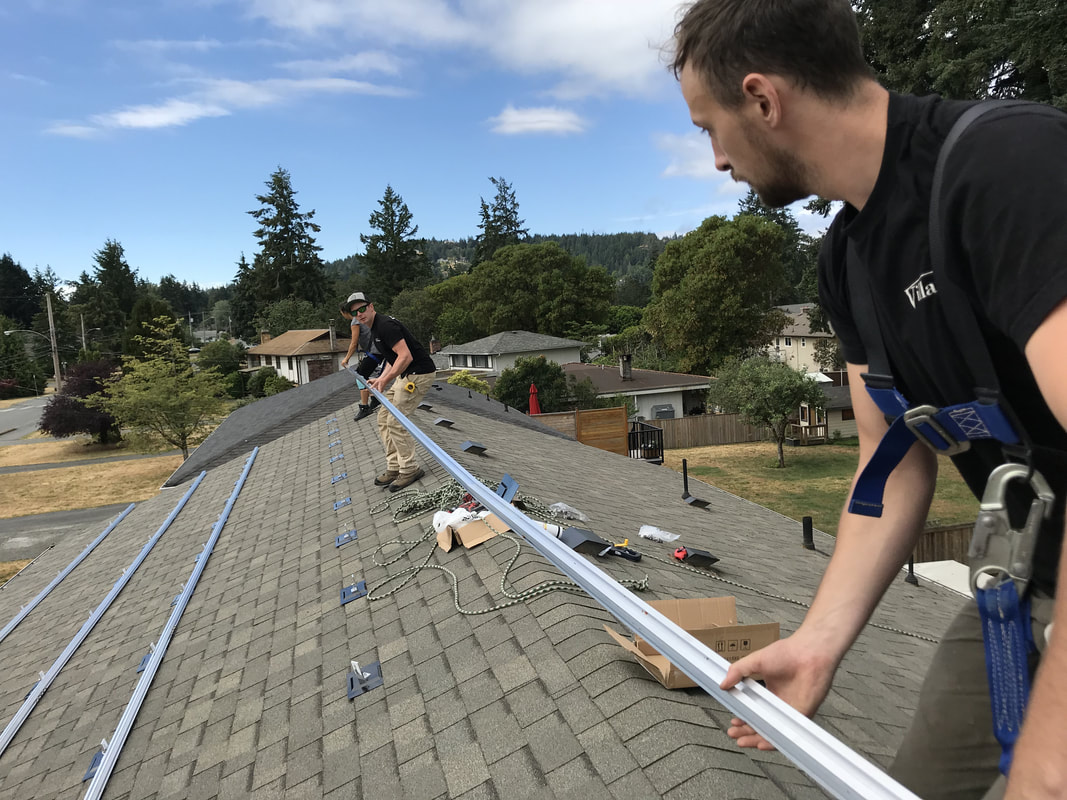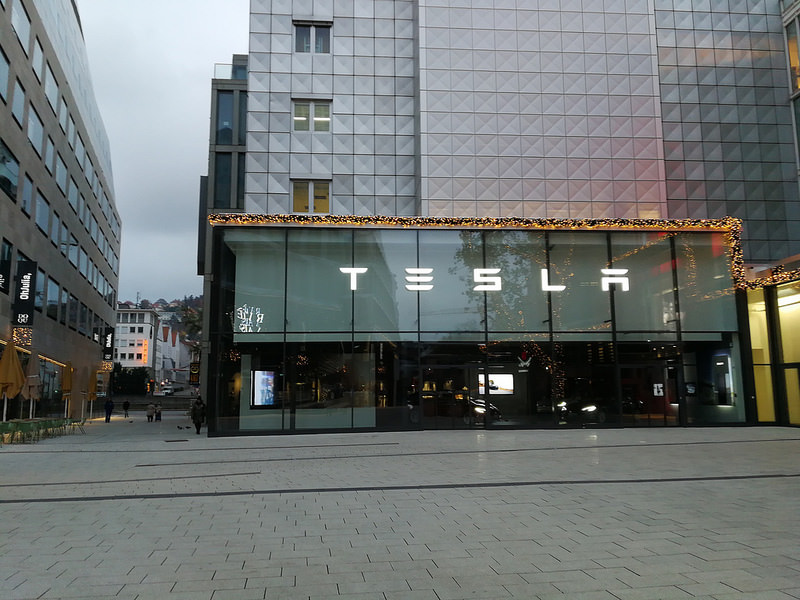Power Up has recently established a relationship with yet another developer who's taken his interest in solar VERy seriously. He's gone beyond offering solar as an option, but has built it into the prices of the 22 homes on a newly developed street in royal bay (Greater victoria BC NEIGHBOURHOOD).
4 Comments
Our latest project in Colwood BC was a success!
This system was designed to maximize the south facing roof space to offset the highest percentage of the customers hydro usage. We chose the highest wattage panels that were available on the market, and strung them all to a high capacity inverter which will invert the DC power that the panels produce into AC power that will run this family's home. So what are the numbers?! This system will produce 90% of the homeowners annual energy usage with a 13.3% average annual ROI, and a sub-eleven year pay back period. WOW! Imagine if we could pay hydro prices from 25 years ago! That dream will be these clients reality as they look back on this investment over the next two and a half decades. We've all caught drift of Elon Musk's recently launched solar shingles with the incredible curb-appeal and 'affordable' price tag. There's no denying that while Musk's solar solution is one of the best aesthetically, it has not yet arrived at a reasonable price point. The objective of this post is to briefly contrast Tesla solar against your traditional solar arrays.
Materials costs have come a long way down in the last decade making solar affordable for most Canadian homeowners. While we expect Tesla's solar roof to do the same, it will forever be in the upper category of solar options for your home. This is a good thing, and there is nothing wrong with having options out there especially for an environmentally driven company like Tesla. But, home-owners need to know it is not 'just as affordable as a regular roof'! In this statement, Musk is referring to a 'regular roof' as a slate roof, which is often triple the cost of a asphalt roof. Compared to a slate roof, which will last forever, then yes, the production of power from the solar shingles make it a far more affordable roof for your home. For those who don't wish to spend $100k on a lifetime roof, Power Up Solar can help. At a fraction of the cost, we suggest you suggest a regular asphalt or metal roof, AND have panels installed on your roof that will out-perform Tesla's solar roof production for a fraction of the price. Forbes described it best: "there’s about as much market for Tesla’s new roof as there was for the $17,000 gold Apple Watch". This analogy is perfect (though it is not fact). Apple tried to put smart watch technology that was no better than its competition, into a gold band to compete with high end watching like Rolex and Breitling. Unfortunately, pairing technology with expensive and long-lasting durable products like gold does not work. Technology evolves far to quickly to be confined with luxury materials that are made to last a lifetime. In twenty years from now, when the Tesla Solar shingles are still looking great and holding strong, imagine where the solar industry will be? Apple learned this the hard way when not a single Gold Apple Watch sold as the tech in that watch will long outdated in just a few years from now. What Tesla is doing is awesome and positive for the solar industry. If anything, its putting solar on the map for a lot of people who wouldn't have found it interesting before. And thankfully, their motive to see an emissions free world is pure and genuine. They're marketing could be a little more accurate, but overall, it is a durable roof, and it does produce power. If you can afford this roof, we'd love to come over and see it in person! Clover, J. (n.d.). Apple Discontinues Gold Apple Watch Edition Models. Retrieved June 1, 2018, from https://www.macrumors.com/2016/09/07/apple-discontinues-apple-watch-edition-gold/ Helman, C. (2017, May 19). Elon Musk's New Solar Roof Won't Save Tesla's Solar Business. Retrieved June 1, 2018, from https://www.forbes.com/sites/christopherhelman/2017/05/17/elon-musks-new-roof-for-rich-green-people-wont-save-teslas-solar-business/#3a5888ed6171 Solar Roofing will be Cheaper than Regular Roofing. (2017, May 15). Retrieved June 1, 2018, from http://www.nationalgeographic.com.au/engineering/solar-roofing-will-be-cheaper-than-regular-roofing.aspx The one-year anniversary of the BC Step Code’s introduction has come and gone this past April. For now, the code remains to be a resource for all 160 individual municipalities in BC to choose whether or not to implement to one degree or another. Its objective is to introduce the long-term goal of all new homes in BC to be net-zero ready homes by 2032. A net-zero homes means that a home’s total power production is close to or equivalent to the amount of power the homes consumes over the course of a year. BC municipalities were given permission to start enforcing the code as early as December 15th, 2017. It is encouraging to see more and more of the governments support and attention spent on building greener homes and transitioning the industry to have less of a footprint on planet earth. While the motive of the step code is good, its execution and structure could use some improving. We got to chat with Casey Edge by phone, who is the Executive Director for the Victoria Residential Builders Association and well-versed expert in the building industry as it relates to energy efficiency. He summarized our interview saying, “the issue isn’t new homes!”– the issue is old homes sweating off their heat that are not built to the same basic standards of efficiency that exists today. According to the BC Step Code, new homes that are net-zero ready will be 1%-3% (or $17,000) more expensive to build than a regular home. This is an understatement as builders in Victoria claim more realistic numbers “$55k-$110k, or an average of $80k”, says Casey. The step codes estimations, at least for the Victoria (and likely Vancouver) market, are severely light. Casey shares in our opinion that the smarter approach for builders and their clients is to invest in solar panels that cost a fraction of the price. Keep in mind, that $80k is just for a net-zero ready home, this is not yet a net-zero home without a way of produce its own power. When included in the original design of a new home, solar can be extremely affordable and wildly productive for the home owner’s energy production. The designer can consider things like electrical supply, orientation of the home, and the location of roof penetrations to ensure the most south facing square footage. This traditionally cost a fraction of the average net-zero ready home, is far better for the environment, and will much quicker achieve what the step code has tried to accomplish. As if that wasn’t good enough, the payback period for the initial investment is under 15 years in most case scenario’s. For an older home, retrofitting a roof with solar is far less expensive than updating the walls and windows and attic of a house to insulate the heat. In summary, the BC Step Code is a genuine attempt to make an impact on the environment that could be far better executed by a Home Renovation Grant that would apply to both old and new homes to incentivise energy efficiency and power production. Casey feels the reason the government did not propose this is because it would shift the cost from the homeowner spending an extra $80k on building a passive home to the government who incurs the cost of the awarded grants. Power Up Solar is exciting about the VRBA’s awareness and support for smarter power production and more efficient homes. The next steps for us include approaching builders and being part of the References: Edge, C., VRBA. (n.d.). The BC Step Code and Solar. Phone Interview, Case Edge. Retrieved May 17, 2018. BC Energy Step Code. (2017). Online Government Document, 1-51. Retrieved May 17, 2018, from https://www2.gov.bc.ca/assets/gov/farming-natural-resources-and-industry/construction-industry/building-codes-and-standards/guides/bcenergystepcode_guide_v1.pdf. http://www.cbc.ca/news/canada/british-columbia/bc-hydro-excess-power-payout-solar-1.4645851
In summary, the net metering program still exists wherein BC Hydro buys back your excess power in the form of a credit on your bill so long as at the end of the year, they don’t have to write you cheque. This applies to VERY few homes in Victoria that have enough solar that their net power production is more than their usage therefor expecting a check from hydro. For most homes, where solar is offsetting hydro usage and not exceeding it, this does not affect them. |
Details
AuthorAs a local (to lower Vancouver island) solar installer, we're very much on top of the latest new and trends in the industry and want to use this blog tool as a way of commenting and clarifying relevant information to the reader. |








